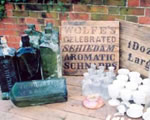 Go to main content
Go to main content
Archive Website of the UK government
Please note that this website has a UK government accesskeys system.
Main menu
Page menu
Travel and transport

What to do if you recover wreck material

If you recover wreck material - for example, parts of a ship or its cargo or equipment - you must report it to the 'Receiver of Wreck'. Find out what wreck material is and how to contact the Receiver of Wreck.
What is wreck material
'Wreck' material includes things found on the sea shore or in tidal water that have come from a ship, aircraft or hovercraft (vessels). This could be parts of the vessel, its cargo or equipment.
Wreck material normally falls into four main categories:
- 'flotsam' - goods that have remained afloat after being lost from a ship that has sunk
- 'jetsam' - things that have been cast overboard from a ship that was in danger of sinking
- 'derelict' - property that has been abandoned at sea without hope of recovering it, which could be vessels or cargo
- 'lagan' - goods that have been buoyed (so they can be recovered) before being cast overboard from a ship that then sinks
Wreck material doesn't normally include:
- boats that have come off their moorings
- buoys, for example marker or mooring buoys
It does include buoys that form part of fishing equipment.
If you're not sure whether something is wreck material, contact the Receiver of Wreck.
Reporting wreck material to the Receiver of Wreck
The Receiver of Wreck is responsible, by law, for dealing with wreck material recovered within or brought into the UK.
Even if the item is small or seems insignificant, you must report it to the Receiver of Wreck if you either:
- recover wreck material from UK tidal waters
- bring wreck material into UK waters (within 12 nautical miles)
You should report any wreck material within 28 days of recovering it. This gives the legal owner the opportunity to have their property returned.
If you follow the law and report any wreck material you recover to the Receiver of Wreck, you may be entitled to a 'salvage award'. Salvage awards may be paid to legitimate salvors who provide a service to the item's legal owner. By recovering (salvaging) the wreck material, you are helping to return it to its owner. A salvage award recognises your efforts to save the item from danger or destruction.
Wrecks of historical interest
If you think the wreck you've found might be of historical interest, you should contact the local heritage agency before you recover any items. You can email the heritage agencies at the addresses below or visit their websites.
How to report wreck material to the Receiver of Wreck
To report wreck material, complete a Report of Wreck and Salvage form. This form is available directly from the Receiver of Wreck, your local coastguard station, or you can download a copy from the link below.
Once you have completed the form, you'll need to print it out and sign it. You'll also need someone to witness your signature and then ask them to sign the form. Send the completed form to the Receiver.
What happens if you don't report recovered wreck material
It's an offence to recover wreck material without reporting it to the Receiver of Wreck. If you don't report wreck material that you've recovered within 28 days (without a reasonable excuse), you could face a fine of £2,500 per offence. This means, for example, that if you recover two portholes and don't report either of them, you may be fined £2,500 for each porthole.
You may also have to pay twice the value of the find to the person entitled to the wreck. You won't be entitled to a salvage award.
If you hide or refuse to surrender wreck material, you could also face a fine of £2,500 (per offence).
Taking wreck (without reporting it) from UK waters into a foreign port and selling it carries a penalty of up to five years' imprisonment.
What happens to wreck reported to the Receiver
When wreck material is reported, the Receiver of Wreck will look into who owns the wreck items. The owner has one year (from the date the report form is received by the Receiver) to come forward and prove ownership of the items. During this time, the finder is normally allowed to look after the wreck items under certain conditions. These are outlined on the back of the report form. If the owner decides that they would like their property returned, they may have to pay a salvage award to the finder.
If the wreck material isn't claimed within one year, it becomes property of the Crown and the Receiver will dispose of it. This may be through sale or auction. Although, in some cases the finder may be allowed to keep unclaimed wreck in place of a salvage award.
If the wreck material is historically or archaeologically important, the Receiver will try to place it in an appropriate museum. For more information about what happens to wreck material, contact the Receiver of Wreck.
The Receiver of Wreck and protected wrecks
Under Section 2 of the Protection of Wrecks Act, the Receiver of Wreck administers ship wreck sites that are designated as dangerous. One of these wrecks is the SS Richard Montgomery, which lies across the tide close to the Medway Approach Channel. There are still approximately 1,400 tons of explosives contained within the forward holds of the ship.
The Receiver of Wreck monitors the condition of the wreck - even though the risk of a major explosion is believed to be remote. The Receiver carries out regular surveys of the site to be sure that any changes to the wreck, or its immediate environment, are discovered quickly.
 Facebook
Facebook Twitter
Twitter StumbleUpon
StumbleUpon Delicious
Delicious Reddit
Reddit